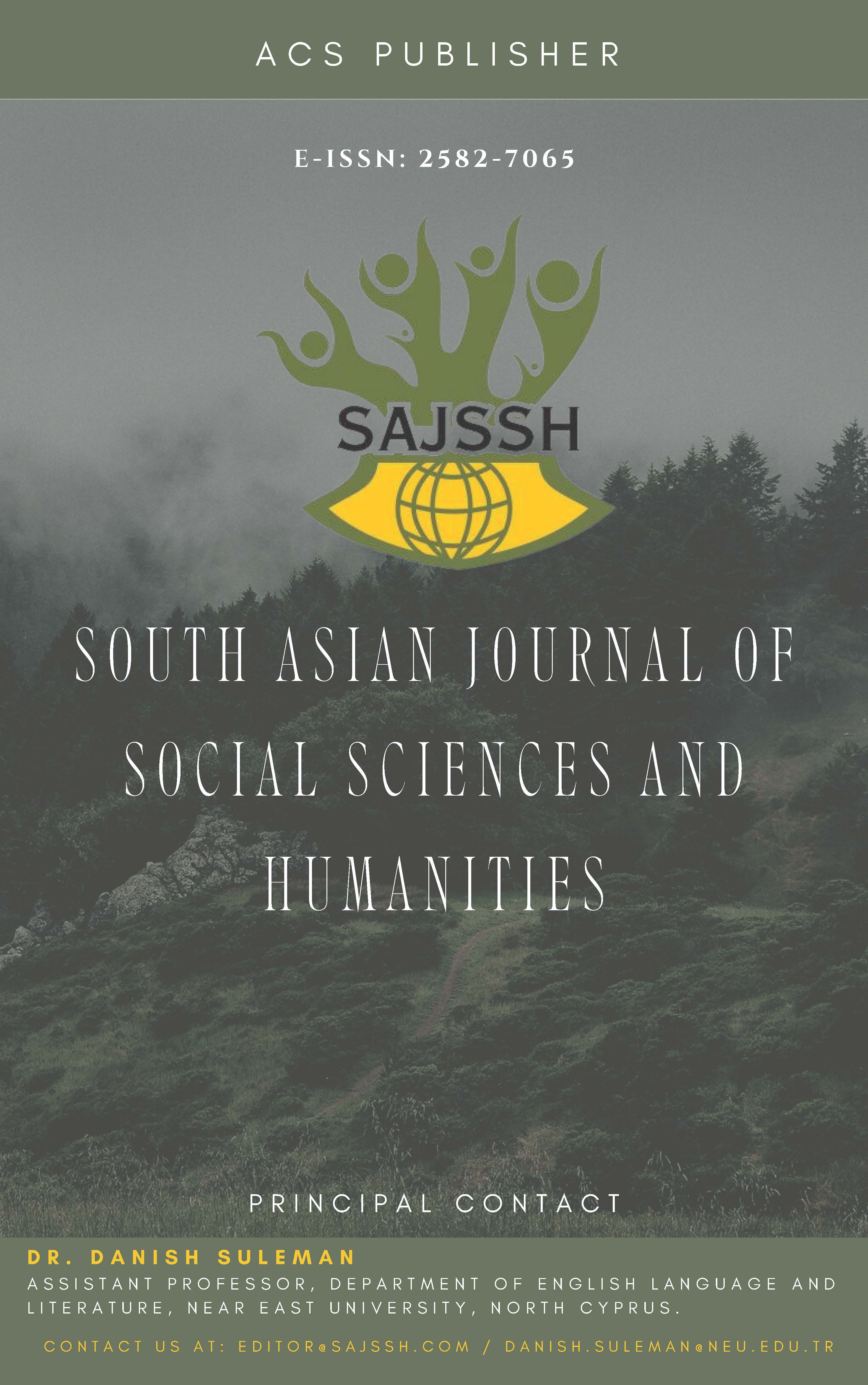Exploring Complex Dynamics of Early Marriage in Rural Bangladesh: Reasons, Psycho-Social, Health and Economic Implications
DOI:
https://doi.org/10.48165/sajssh.2024.6105Keywords:
Complex Dynamics, Early Marriage, Reasons, Psycho-social Consequences, Health Implications, Economic Impacts, Rural BangladeshAbstract
Early marriage remains a significant concern in rural regions of Bangladesh, making it imperative to examine the causes, psycho-social consequences, and economic impacts of early marriage. The cross-sectional study explored these complex dynamics and interviewed 400 girls/women who married before 18 in four selected districts. Descriptive and inferential statistics revealed early marriage being greatly influenced by family attitudes (62.85%) & economic pressures (42.2%). Furthermore, forcible family opinions (75.71%) with the groom’s pressure (12.85%) and love relationships (14.28%) played a major role in early marriage. Early married girls experienced depression & sadness (44%), malnutrition (42%), disrupted education (60%) and other economic challenges. Dowries impacted families massively, where 60% provided dowry by taking loans (60.37%) due to having no other option. Early-married girls faced significant hardships, enduring psycho-social and economic oppression that severely impacted their quality of life. There is a need to integrate education, awareness, and policy reforms to mitigate the far-reaching consequences of early marriage.
References
Afzal, F., Das, A., & Chatterjee, S. (2024). Drawing the Linkage Between Women’s Reproductive Health, Climate Change, Natural Disaster, and Climate-driven Migration: Focusing on Low and Middle-income Countries Systematic Overview. Indian Journal of Community Medicine, 49(1), 28-38.
Afzal, F., & Das, A. (2023). Predictors of antenatal health service utilization among left behind wives of male outmigrants: Evidence from Patna District, India. Asian Pacific Journal of Reproduction, 12(5), 220-228.
Afzal, F., Das, A., & Ali, Q. A. (2022). Reproductive Health of Outmigrant’s Left-Behind Wives Residing in Indian Subcontinent–A Systematic Review Encompassing Mental Stress, Autonomy and Patriarchy. Neuroquantology, 20(7), 2719.
Abdullah, S., Qureshi, H., & Quayes, S. (2015). The adverse effect of child marriage on women’s economic wellbeing in Bangladesh – can microfinance help? The Journal of Developing Areas, 49(4), 109–125. https://doi.org/10.1353/jda.2015.0148
Bangladesh Bureau of Statistics (BBS) & ICF. (2019). Bangladesh Demographic and Health Survey 2017-18. Dhaka, Bangladesh, and Rockville, Maryland, USA: BBS and ICF.
Chowdhury, F. D. (2004). The socio-cultural context of child marriage in a Bangladeshi village. International Journal of Social Welfare, 13(3), 244–253. https://doi.org/10.1111/j.1369-6866.2004.00318.x
Chowdhury, J. S., & Akhter, S. (2017). Early marriage and psychosocial wellbeing: A study on women in Bangladesh. BMC Public Health, 17(1), 936.
Chowdhury, R. I., & Mukherjee, A. (2014). Social determinants of age at marriage among rural women in Bangladesh. Indian Journal of Public Health, 58(1), 22-25.
Jain, S., & Kurz, K. (2007). New insights on preventing child marriage. A global analysis of factors and programs. Retrieved August 23, 2023, from Save the Children’s Resource Centre website: https://resourcecentre.savethechildren.net/document/new-insights preventing-child-marriage-global-analysis-factors-and-programs/
Kamal, S. M. M., Hassan, C. H., Alam, G. M., & Ying, Y. (2014). Child Marriage In Bangladesh: Trends and Determinants. Journal of Biosocial Science, 47(1), 120–139. https://doi.org/10.1017/s0021932013000746
Nahid, F. (2014). Child marriage in Bangladesh: Socio-legal analysis. International Journal of Sociology and Anthropology, 6(1), 1–7. https://doi.org/10.5897/ijsa11.024
Nasrin, O. (2012). Factors affecting early marriage and early conception of women: A case of slum areas in Rajshahi City, Bangladesh. International Journal of Sociology and Anthropology, 4(2), 54–62. https://doi.org/10.5897/ijsa11.145.
Nasrullah, M., Muazzam, S., Bhutta, Z. A., & Raj, A. (2014). Girl child marriage and its effect on fertility in Pakistan: Findings from Pakistan Demographic and Health Survey, 2006-2007. Maternal and Child Health Journal, 18(3), 534-543.
NIPORT. (2019). Bangladesh Demographic and Health Survey 2017-2018. National Institute of Population Research and Training.
Patoari, Md. M. H. (2020). Causes and Effects of Child Marriage in Bangladesh: A Case Study at Halishahar, Chattogram, Bangladesh. Academic Journal of Interdisciplinary Studies, 9(2), 162. https://doi.org/10.36941/ajis-2020-0034.
Rahman, M. M., Kabir, M., Shahidullah, S. M., & Chowdhury, A. H. (2018). Early marriage and intimate partner violence among adolescents in Bangladesh. Journal of Interpersonal Violence, 0886260518807890.
Sahota, R., Das, A., & Afzal, F. (2024). Determinants of data use for programmatic evidence based decision making at peripheral public health care centres in Haryana, India. Clinical Epidemiology and Global Health, 29, 101713. https://doi.org/10.1016/j.cegh.2024.101713
Sahota, R., & Das, A. (2024). Developing an instrument for assessing determinants of data use in evidence-based decision making: A principal component analysis at public primary health centres in Haryana, India. International Journal of Community Medicine and Public Health, 11(12), 4889–4897. https://doi.org/10.18203/2394-
6040.ijcmph20243660
Sinha, N., & Pande, R. (2019). Child marriage and teenage childbearing in rural Bangladesh: Trends and determinants. Journal of Biosocial Science, 51(2), 238-253.
Sobhan, F. (2016). Early Marriage in Bangladesh: Not Only A Legal Issue. The Daily Star. Retrieved from https://www.thedailystar.net/op-ed/politics/not-only-legal-issue 1203210
Trommlerová, S. K. (2020). When children have children: The effects of child marriages and teenage pregnancies on early childhood mortality in Bangladesh. Economics and Human Biology, 39, 100904. https://doi.org/10.1016/j.ehb.2020.100904.
UNICEF. (2014, July 22). Ending Child Marriage: Progress and prospects - UNICEF DATA. Retrieved from UNICEF DATA website: https://data.unicef.org/resources/ending child-marriage-progress-and-prospects/
UNICEF. (2020, May 4). Ending Child Marriage: Progress and Prospects. Retrieved from UNICEF Global Development Commons website: https://gdc.unicef.org/resource/ending-child-marriage-progress-and-prospects.
Yount, K. M., Crandall, A., Cheong, Y. F., & Osypuk, T. L. (2016). Young women’s age at marriage and long-term economic empowerment in rural Bangladesh. Journal of Population Economics, 29(3), 889-914.
Yount, K. M., Crandall, A., Cheong, Y. F., Osypuk, T. L., Bates, L. M., Naved, R. T., & Schuler, S. R. (2016). Child Marriage and Intimate Partner Violence in Rural Bangladesh: A Longitudinal Multilevel Analysis. Demography, 53(6), 1821–1852. https://doi.org/10.1007/s13524-016-0520-8.
Downloads
Published
Issue
Section
License
Copyright (c) 2025 South Asian Journal of Social Sciences and Humanities

This work is licensed under a Creative Commons Attribution 4.0 International License.





